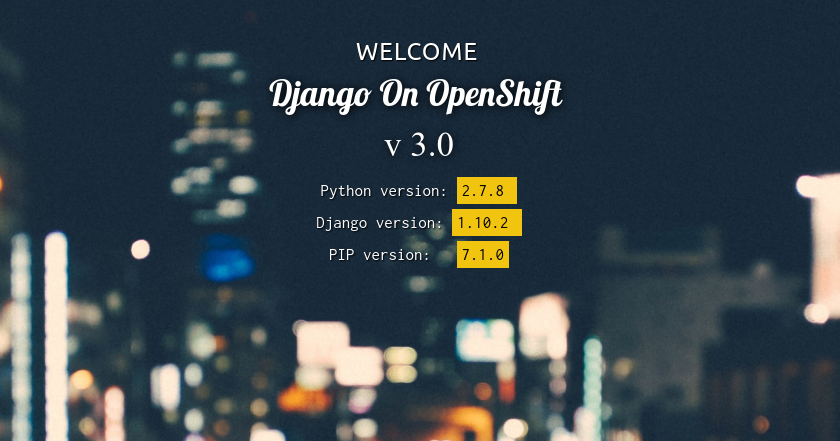
Django on OpenShift is a independent fork of openshift-django17 by John Flynn Matthew.
Previous versions and supported Django versions
| Version | Django Version | Tag | Browse |
|---|---|---|---|
| 3 | 1.10 | v3 |
v3 |
| 2 | 1.8 LTS | v2 |
v2 |
###Features
- Ready to use for local development
- Easy to push to OpenShift
- Works with either PostgreSQL or MySQL
- Minimal changes to default django 1.10.x LTS installation
- Support to new template configurations for Django 1.8.x LTS
- Support for multiple template engines
- Uses new folder layout from OpenShift March 2014 release
- Allows for debug mode on OpenShift with the help of an environment variable.
- Use of static files is pre-configured
- Preloads Bootstrap and jQuery cdn versions
- New Demo app to display software information
- Code formatting as per PEP8 recommendations
###How to use this repository
-
Create an account at https://www.openshift.com
-
Install the RHC client tools if you have not already done so.
sudo gem install rhcrhc setup -
Create a Python 2.7 application
rhc app create django python-2.7 -
Add the database cartridge (choose one)
rhc add-cartridge postgresql-9.2 --app django
OR
`rhc add-cartridge mysql-5.5 --app django`
- Add this upstream repo
cd django
git remote add upstream -m master https://github.com/biwin/Django-on-OpenShift.git
git pull -s recursive -X theirs upstream master
-
set the WSGI application to django's built in WSGI application (stored in the wsgi folder).
rhc env set OPENSHIFT_PYTHON_WSGI_APPLICATION=wsgi/wsgi.py --app django -
Push the repo upstream
git push -
SSH into the application to create a django superuser.
python app-root/repo/manage.py createsuperuser -
Now use your browser to connect to the Admin site.
Static files are already setup and ready to use for either local or OpenShift use.
Place all static files / folders into the project-directory/static. They will be collected with collectstatic when
pushed to OpenShift.
DO NOT PUT STATIC FILES INTO /wsgi/static/, this is merely a place holder for the collectstatic command.
You are free to place the HTML template files either on the separate template directory or in-app template directory or on both. Your HTML templates can be placed on,
project/templatesproject/app/templates
This repository was designed to allow you to quickly develop and deploy a website to OpenShift. For local development, make sure you have the following setup:
- Virtualenv for this instance of python / django.
- pip (should be installed with virtualenv)
Once you have those installed, install the requirements for this repository:
pip install -r requirements.txt
Once you have django installed, you can continue the tutorial from here https://docs.djangoproject.com/en/1.7/intro/tutorial01/#database-setup, although the default database and application configuration should be sufficient.
When a git push is done, the ``.openshift/action_hooks/deploy` is executed. This script does two things:
- Runs python manage.py migrate to update any changes to the Schema
- Runs python manage.py
collectstaticto move all necessary static files into /wsgi/static
By default, debug mode is off when pushed to OpenShift. However, if you'd like to turn on debugging (settings.DEBUG) while running on OpenShift, you can set the environment variable DEBUG to True and then stop and start your application, and debugging will be turned on.
rhc env set DEBUG=True
HTTPS redirection is accomplished by telling the local Apache gear to redirect all traffic to the HTTPS version of your site. You'll need to add an .htaccess file into the WSGI folder
Add the following .htaccess file into the WSGI folder
RewriteEngine on
RewriteCond %{HTTP:X-Forwarded-Proto} !https
RewriteRule .* https://%{HTTP_HOST}%{REQUEST_URI} [R,L]
This will redirect ALL HTTP traffic to the site to HTTPS.
This setup works with python 2.7 and 3.3. Issues, pull requests are welcome.